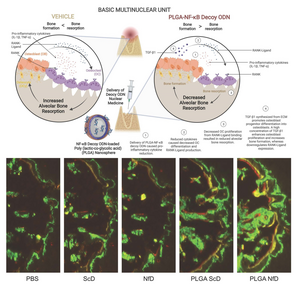A gene delivery therapy developed by Tokyo Medical and Dental University effectively suppresses inflammation to enhance tissue healing after tooth extraction. The therapy uses an efficient copolymer vector to deliver NF-κB decoy ODNs to the extraction socket of rats, which inhibits bone resorption and promotes bone formation. The local administration of NF-κB decoy ODNs effectively prevents excessive inflammation and promotes bone healing. The findings may lead to innovative gene therapy to prevent residual ridge resorption after surgical tooth extraction. Inhibitors of NF-κB are widely recognized in the treatment of bone resorption, but the application of an NF-κB decoy oligodeoxynucleotide (ODN) has been poorly investigated. The study provides important new insights into the use of an NF-κB decoy ODN as a treatment for bone resorption.
Polymeric Gene Delivery Therapy Promotes Bone Formation
Researchers from Tokyo Medical and Dental University (TMDU) have developed a polymeric gene delivery therapy that promotes new bone formation after traumatic inflammation. The study published in the International Journal of Molecular Sciences reveals that the therapy can effectively suppress inflammation to enhance tissue healing after tooth extraction.
Tooth extraction is a common surgical procedure in dental medicine that triggers a physiological healing process involving the reconstruction of damaged soft and hard tissues. However, excessive inflammation can cause residual ridge resorption, reducing the residual bone in the jaw and inducing a negative impact on dental surgery.
The research team investigated the therapeutic effect of NF-κB decoy ODNs administered by a copolymer vector in bone healing after tooth extraction. They found that the polymeric nanoparticle gene delivery system inhibits osteoclast differentiation and inflammatory cells, including the reduction of alveolar bone resorption. This allows the continuing dynamic healing potential to accelerate new bone formation in the extraction socket.
The study demonstrates the potential of a polymeric nanoparticle gene delivery system in regenerative medicine. This cutting-edge gene therapy could be a “magic bullet” that regenerates tissues damaged by disease or trauma. By promoting new bone formation after traumatic inflammation, the therapy can restore hope for bone regeneration.
In conclusion, the polymeric gene delivery therapy developed by TMDU researchers effectively suppresses inflammation to enhance tissue healing after tooth extraction. The therapy inhibits osteoclast differentiation and inflammatory cells, promoting new bone formation in the extraction socket. This breakthrough has the potential to revolutionize regenerative medicine and restore hope for bone regeneration.
Gene Delivery System Promotes Bone Healing after Tooth Extraction
Bone remodeling throughout life is regulated by a signaling pathway involving NF-κB, a protein complex that controls genes that regulate inflammation and bone healing. Researchers have developed a gene/drug delivery system that effectively inhibits bone resorption and promotes bone formation at the extraction socket after tooth extraction. The study, published in the International Journal of Molecular Sciences, found that the local administration of NF-κB decoy ODNs (double-stranded DNA fragments) using a copolymer vector inhibited bone resorption, promoted bone formation, and prevented excessive inflammation.
The gene delivery therapy developed by the researchers utilizes an efficient copolymer vector to deliver NF-κB decoy ODNs to the extraction socket of rats. The therapeutic effects were then investigated, and it was found that the local administration of the NF-κB decoy ODNs effectively inhibited bone resorption and promoted bone formation. This is the first in-vivo study revealing the efficacy of NF-κB decoy ODNs administered by a copolymer vector to promote bone healing after tooth extraction.
The findings of this study may lead to innovative gene therapy to prevent residual ridge resorption after surgical tooth extraction. Inhibitors of NF-κB are widely recognized in the treatment of bone resorption, but the application of an NF-κB decoy oligodeoxynucleotide (ODN) has been poorly investigated. The study’s lead author, Takashi Ono, explains that this research provides important new insights into the use of an NF-κB decoy ODN as a treatment for bone resorption.
In conclusion, the gene delivery system developed by the researchers effectively inhibits bone resorption, promotes bone formation, and prevents excessive inflammation after tooth extraction. This breakthrough has the potential to revolutionize the treatment of bone resorption, particularly in preventing residual ridge resorption after surgical tooth extraction.
Don’t miss interesting posts on Famousbio










